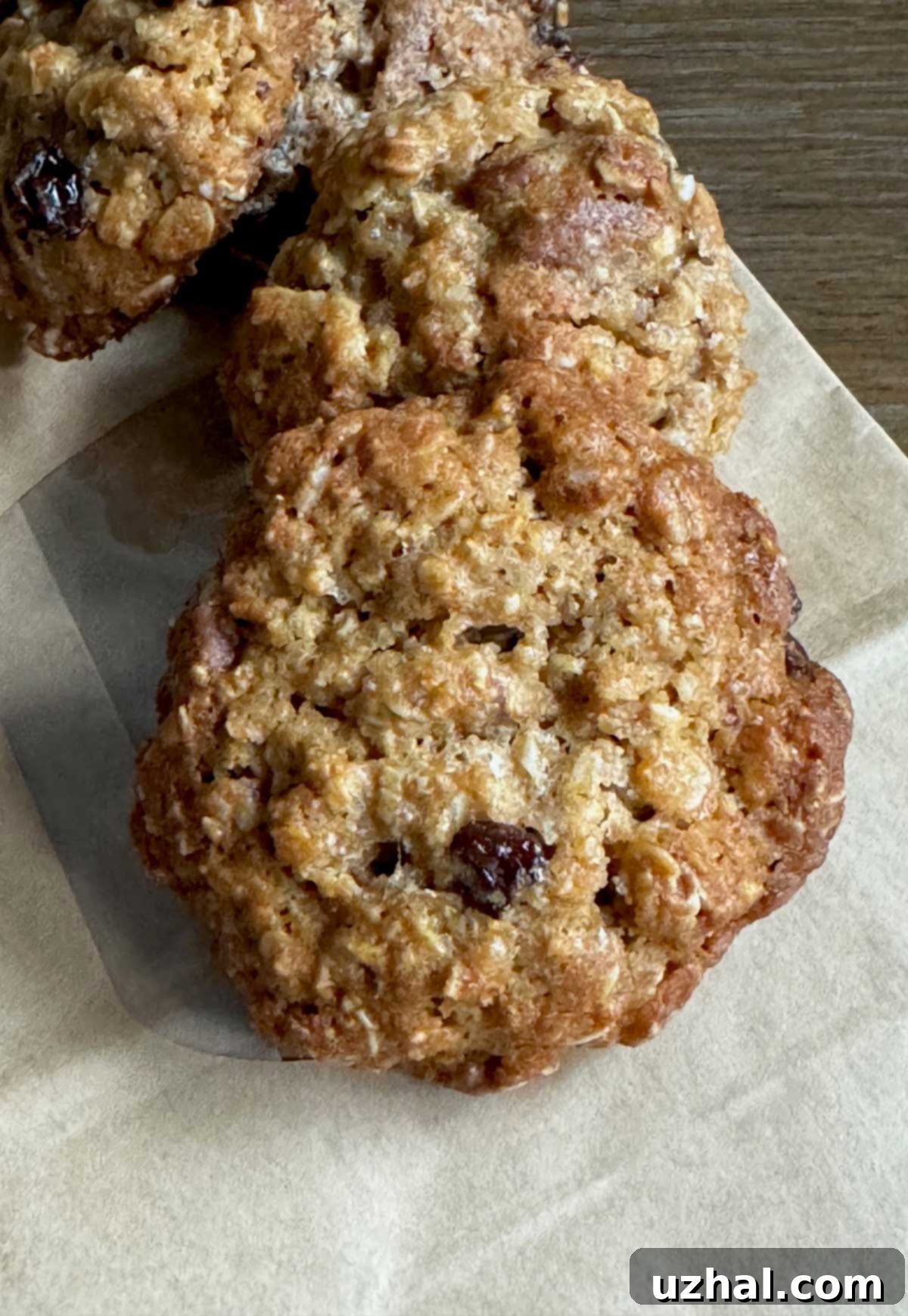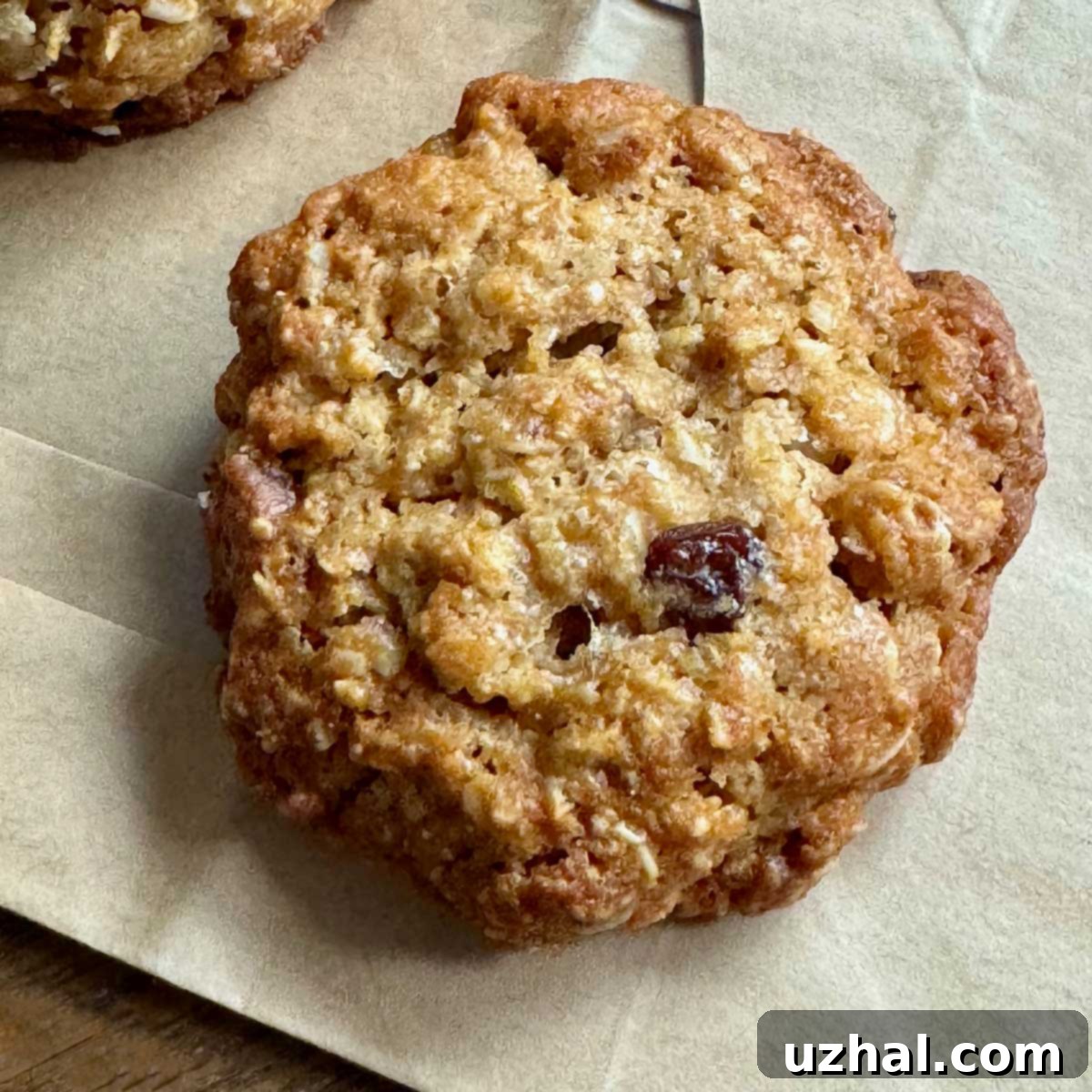Deliciously Guilt-Free: The Ultimate Recipe for Almost Sugar-Free Oatmeal Cookies
Craving a classic, comforting cookie without the guilt of added sugar? Look no further! This recipe for almost sugar-free oatmeal cookies offers a delightful solution, inspired by a humorous stevia commercial (link to the video provided below if you’re in the mood for a chuckle). While we can’t call them completely “sugar-free” due to the natural sugars found in ingredients like raisins and molasses, there is absolutely no added table sugar, brown sugar, coconut sugar, or any refined sugar. The wonderful sweetness in these cookies comes entirely from your choice of alternative sweeteners such as Swerve, Lakanto Gold, Monk Fruit, Allulose, or your preferred sugar substitute. This innovative approach allows you to indulge in a beloved treat while maintaining a mindful approach to your sugar intake, making them an ideal choice for a healthier lifestyle or specific dietary needs.

Exploring the Best Alternative Sweeteners for Baking
This recipe is a refined version of an old favorite, originally crafted using Stevia Sun Crystals – a product that is now hard to find. To bring this beloved cookie back to life, we’ve extensively tested and perfected it with a variety of modern alternative sweeteners. We found that Swerve Granular, Lakanto Golden Monk Fruit Erythritol Blend, and Monk Fruit in the Raw all performed beautifully, yielding delicious results. Each of these options offers a clean sweetness without the aftertaste often associated with some artificial sweeteners, making them fantastic choices for baking. Swerve, primarily an erythritol blend, measures cup-for-cup like sugar and bakes exceptionally well. Lakanto Gold, a monk fruit and erythritol blend, mimics brown sugar, adding a lovely depth of flavor. Monk Fruit in the Raw provides a potent, natural sweetness that blends seamlessly into the dough.
Driven by curiosity, we also experimented with allulose. As anticipated, cookies made with allulose boasted the most exquisite taste, closely mirroring traditional sugar in flavor. However, it’s worth noting that allulose imparts a distinctly softer, chewier texture, which some might prefer. This unique characteristic is due to allulose’s molecular structure, which doesn’t recrystallize as readily as other sweeteners, thus retaining more moisture. For those who prioritize taste and a soft bite, allulose is an excellent contender, though you may need to adjust the amount slightly due to its slightly lower sweetness profile compared to erythritol-based blends. Understanding these nuances allows you to choose the perfect sweetener for your desired cookie profile.
Effortless Baking: An Easy One-Bowl Recipe
Simplicity is key with this recipe, designed to be incredibly easy and minimize cleanup. Everything comes together in a single bowl, making it perfect for busy weekdays or when you want a quick dessert fix. The process begins by creaming together very soft butter, your chosen alternative sweetener, a touch of molasses for depth, and warm cinnamon for that classic oatmeal cookie spice. Next, an egg is incorporated, followed by a hint of vanilla extract to enhance the flavors. Then, baking soda, salt, and any additional spices are added and mixed in. Finally, the dry ingredients – flour, hearty old-fashioned oats, plump raisins, and crunchy nuts – are folded into the mixture. This streamlined method ensures a consistent dough with minimal fuss.
Once your dough is ready, you have options! You can immediately scoop the dough onto a baking sheet and bake for instant gratification. Alternatively, for those who appreciate fresh-baked cookies on demand, you can scoop the dough portions, cover them, and chill them in the refrigerator, or even freeze them for later. Having a freezer full of ready-to-bake, almost sugar-free oatmeal cookie dough is a lifesaver for unexpected cravings or impromptu gatherings. The dough also benefits from a brief chill, which can help develop flavors and improve the cookie’s texture during baking, making them slightly thicker and chewier.
Understanding Sweeteners: Splenda Stevia & Magic Baker
Speaking of sweeteners, let’s revisit the inspiration for this recipe – that hilarious stevia commercial. It promotes a stevia product from Splenda, a brand traditionally recognized for sucralose. However, Splenda has broadened its horizons, now offering a range of stevia-based products and other innovative sweetening blends, reflecting the growing demand for natural, low-calorie alternatives. One notable product is Splenda’s Magic Baker blend, which is a personal favorite for many baking applications. While I didn’t have it on hand for the extensive testing of this specific recipe, I am highly confident that its balanced blend and baking-optimized properties would yield perfectly delicious results here, offering excellent texture and sweetness. It’s designed to provide a cup-for-cup sugar replacement, which greatly simplifies recipe conversions and ensures consistent baking performance, making it a reliable choice for any baker looking to reduce sugar without compromising taste or quality.
Expert Baking Notes for Perfect Almost Sugar-Free Oatmeal Cookies
Achieving the perfect batch of almost sugar-free oatmeal cookies requires attention to detail. This section provides critical baking notes and tips to help you get the best results every time. These insights come from extensive testing and understanding how ingredients interact when traditional sugar is replaced with alternative sweeteners. If you encounter any issues, please don’t hesitate to reach out; we’re always happy to assist with adjustments.
- Butter Selection: Our tests primarily utilized unsalted butter, which allows for precise control over the overall saltiness of the cookies. If you opt for salted butter, remember to significantly reduce the added salt in the recipe, typically by at least half. We also experimented with a stick of Country Crock, a plant-based spread. When using Country Crock, further reduce the salt to approximately ⅛ teaspoon to prevent an overly salty taste, as these spreads often contain higher sodium levels than butter. The fat content and consistency of your chosen butter or spread will influence the cookie’s texture, so using softened butter is crucial for proper creaming.
- Sweetener Adjustments: We intentionally kept the amount of alternative sweetener as minimal as possible, leveraging the natural sweetness provided by the raisins and molasses. If you decide to use straight allulose, you’ll need to increase the quantity by about 1⅓ times (e.g., approximately 160 grams instead of 125 grams of erythritol-based blends). Allulose is generally less sweet gram-for-gram than erythritol and other high-intensity sweeteners, and it also contributes to a softer texture, so this adjustment helps achieve the desired sweetness level without making the cookies too firm.
- Flour Type and Dough Management: Our preferred flour for this recipe is King Arthur all-purpose flour. Its slightly higher protein content compared to some other brands helps the cookie dough maintain its shape during baking, preventing excessive spreading. It also contributes to a pleasant chewiness. As the dough rests, the flour and oats will absorb more moisture, which can affect consistency. If you plan on refrigerating the dough for later baking, we strongly recommend scooping out individual portions and flattening them slightly before chilling. This makes them easier to handle and bake directly from the fridge. If baking immediately after mixing, you can simply scoop and bake.
- Raisins and Dried Fruit: Raisins are not just for flavor; they contribute natural sugars and moisture, and their chewiness is a hallmark of a great oatmeal cookie. If you must omit them for a stricter low-sugar diet, increase the alternative sweetener by ½ tablespoon to compensate for the lost sweetness. Feel free to substitute raisins with other dried fruits like dried cranberries, chopped apricots, or even sugar-free chocolate chips for a different twist. Just remember that each substitution may slightly alter the nutritional profile and texture.

Creative Variations and Customizations
This almost sugar-free oatmeal cookie recipe is incredibly versatile, lending itself to countless delicious variations. Don’t be afraid to get creative and experiment with different flavor combinations and mix-ins! We tried one batch with dried cranberries and a splash of Olive Nation maple extract, and the results were absolutely superb – a delightful autumnal twist. Sugar-free chocolate chips also integrate wonderfully, transforming these into an irresistible oatmeal chocolate chip cookie. The picture above showcases the tempting chocolate chip version, made even more special with specific ingredient choices.
For those looking to significantly reduce the carbohydrate count, consider swapping out the all-purpose flour for a low-carb alternative. We recommend trying Victoria’s Kitchen keto flour blend, which is specifically formulated for baking and can help maintain a similar texture while cutting down on carbs. Another excellent option for reducing carbs and boosting fiber is Fiber Gourmet flour, which we used in place of traditional flour for the chocolate chip batch pictured. For that particular batch, Ghirardelli Bittersweet Chips were used instead of raisins, providing a rich, deep chocolate flavor that perfectly complemented the oats. Other ideas include adding different nuts like walnuts or almonds, a pinch of nutmeg or allspice, or even a hint of orange zest for a brighter profile. The possibilities are truly endless!
The Health Benefits of Oats: More Than Just a Cookie
Beyond being incredibly delicious, these almost sugar-free oatmeal cookies offer a host of nutritional benefits, thanks primarily to their star ingredient: oats. Old-fashioned oats are a whole grain powerhouse, rich in dietary fiber, particularly beta-glucan. This soluble fiber is well-known for its ability to help lower cholesterol levels, support heart health, and regulate blood sugar. Including oats in your diet can contribute to a feeling of fullness, which may aid in weight management, and also promotes healthy digestion. By choosing a recipe that minimizes added sugars, you maximize these inherent health benefits, turning a simple treat into a smart, wholesome snack. These cookies are not just a momentary pleasure but a small step towards a more nourishing diet, providing sustained energy and important nutrients.
Why Choose to Reduce Added Sugar?
In today’s world, where added sugars lurk in countless processed foods, consciously reducing your sugar intake is a powerful step towards better health. Excessive consumption of added sugars has been linked to various health concerns, including an increased risk of type 2 diabetes, heart disease, weight gain, and dental problems. By opting for recipes like these almost sugar-free oatmeal cookies, you take control of what goes into your body. Alternative sweeteners offer a way to enjoy the delightful taste of sweet treats without the detrimental health effects of refined sugars. This approach allows you to satisfy your sweet tooth responsibly, supporting stable energy levels and overall well-being. It’s about making smarter choices that don’t compromise on flavor or enjoyment.
Tips for Achieving the Perfect Sugar-Free Oatmeal Cookies
Mastering the art of baking sugar-free cookies involves a few nuanced techniques. Here are some extra tips to ensure your almost sugar-free oatmeal cookies turn out perfectly every time:
- Room Temperature Ingredients: Always ensure your butter and egg are at room temperature. This allows them to cream together more effectively, creating a smooth, emulsified base that traps air, leading to a lighter, more tender cookie.
- Do Not Overmix: Once you add the flour, mix just until combined. Overmixing can develop the gluten in the flour too much, resulting in tough, chewy cookies instead of soft ones.
- Watch Baking Times: Alternative sweeteners can sometimes affect how cookies brown. Keep a close eye on your cookies as they bake. They should be lightly golden around the edges but still appear slightly soft in the center when removed from the oven. They will firm up as they cool.
- Cooling on the Sheet: Allow the cookies to cool on the baking sheet for a few minutes before transferring them to a wire rack. This helps them set and prevents them from breaking apart.
- Uniform Scooping: Use a cookie scoop or a consistent measuring spoon to ensure all your cookies are the same size. This promotes even baking, so no cookie is undercooked or overcooked.
Storage and Freezing Guidelines
Proper storage is essential to keep your almost sugar-free oatmeal cookies fresh and delicious. Once baked and completely cooled, store the cookies in an airtight container at room temperature for up to 3-5 days. If you’ve opted to chill or freeze the dough, here’s how to handle it:
- Chilled Dough: Scooped portions of dough can be covered and refrigerated for up to 3 days. When ready to bake, place them directly on a baking sheet and add an extra minute or two to the baking time.
- Frozen Dough: For longer storage, freeze scooped dough balls on a parchment-lined baking sheet until solid (about 1-2 hours). Once frozen, transfer them to a freezer-safe bag or container. Frozen dough can be stored for up to 2-3 months. When you’re ready for fresh cookies, bake directly from frozen, adding 3-5 minutes to the total baking time. This is a fantastic way to have homemade cookies available anytime!
Recipe

Almost Sugar-Free Oatmeal Cookies
Anna
Pin Recipe
Ingredients
- 4 oz unsalted butter, softened (114 grams)
- ⅔ cup Swerve Granular, Lakanto Gold Erythritol Monk Fruit or Monk Fruit in the Raw (125 grams)
- ½ tablespoon molasses (10 grams, for flavor and color, not primary sweetness)
- 1 teaspoon ground cinnamon
- 1 large egg
- 1 teaspoon vanilla extract (or you can use ½ maple extract for a different flavor profile)
- ⅜ teaspoon baking soda
- ⅜ teaspoon salt (reduce to ⅛ if using salted butter or Country Crock)
- ⅔ cup all-purpose flour (80 grams, preferably King Arthur for best texture)
- 1 ¼ cups old-fashioned oats (110 grams)
- ⅓ cup raisins (use more or less to taste, or substitute with other dried fruit/sugar-free chocolate chips)
- ⅓ cup toasted pecans, chopped (optional, for added crunch and flavor)
Instructions
-
Preheat your oven to 350 degrees F (175 degrees C). Line a baking sheet with parchment paper or a silicone baking mat.
-
In a large mixing bowl, beat together the softened butter, your chosen alternative sweetener, molasses, and ground cinnamon until the mixture is light, creamy, and smooth. This typically takes 2-3 minutes with an electric mixer.
-
Add the large egg to the creamed mixture and beat until it is fully blended and incorporated. Then, stir in the vanilla extract until just combined.
-
Sprinkle the salt and baking soda directly over the batter and mix until they are thoroughly blended. Next, add the all-purpose flour and stir just until no streaks of flour remain. Finally, fold in the old-fashioned oats, followed by the raisins and chopped nuts (if using), mixing until everything is evenly distributed. Be careful not to overmix.
-
Using a medium-sized cookie scoop (about 1.5 tablespoons) or a heaping tablespoon, scoop uniform balls of dough onto the prepared parchment-lined baking sheet. If you prefer to chill the dough, scoop the portions onto a dinner plate, cover, and refrigerate for at least 30 minutes, or up to 3 days.
-
Bake in the preheated oven at 350 degrees F (175 degrees C) for approximately 12-14 minutes, or until the edges appear golden brown and the centers are set but still slightly soft. For darker, crispier edges, you can try baking at 375 degrees F (190 degrees C), but 350 F is generally a safer bet for consistent results. Allow the cookies to cool on the baking sheet for 5 minutes before transferring them to a wire rack to cool completely.
Notes
Nutrition
We hope this comprehensive guide inspires you to bake a batch of these wholesome and utterly delicious almost sugar-free oatmeal cookies. Whether you’re making them for a special occasion or simply to enjoy a healthier treat, this recipe proves that reducing sugar doesn’t mean sacrificing flavor. Experiment with the sweeteners and variations, and discover your perfect guilt-free indulgence. Happy baking!
